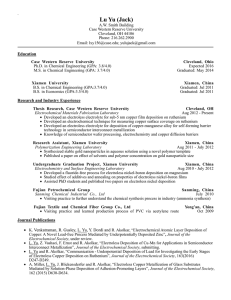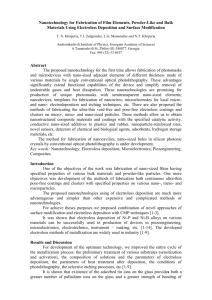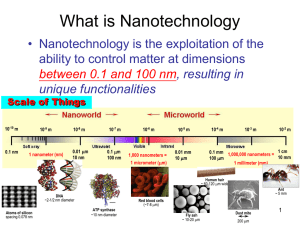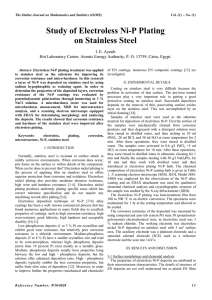(5 lectures) Each lecture 45 minutes
advertisement
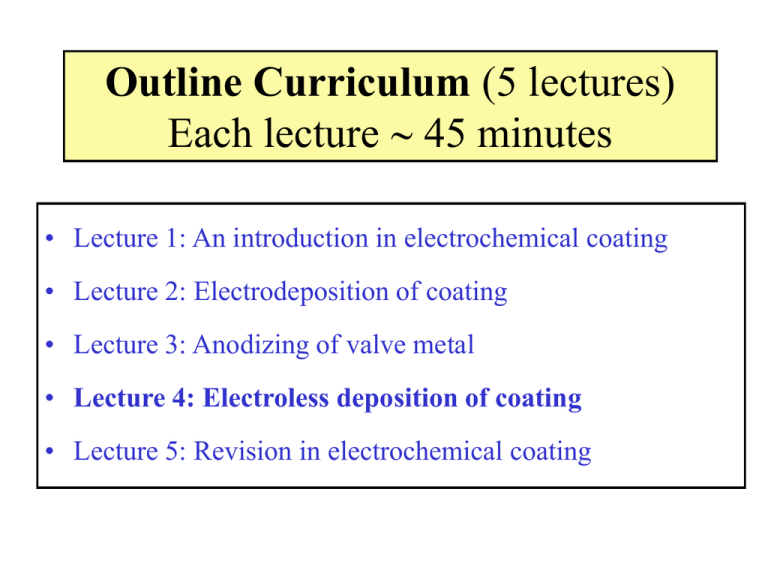
Outline Curriculum (5 lectures) Each lecture 45 minutes • Lecture 1: An introduction in electrochemical coating • Lecture 2: Electrodeposition of coating • Lecture 3: Anodizing of valve metal • Lecture 4: Electroless deposition of coating • Lecture 5: Revision in electrochemical coating Lecture 4 of 5 Electroless Deposition of Coating Electroless deposition • Involves the oxidation of a soluble reducing agent which supports the cathodic deposition of metal on a catalytic surface • Electroless deposition: this process uses only one electrode and no external source of electric current. • Electroless deposition: the solution needs to contain a reducing agent so that the reaction can proceed: • Metal ion + Reduction solution Catalytic surface Metal solid + oxidation solution Typical thickness vs. time profiles Deposit thickness Electroplating Electroless deposition Immersion deposition (thin, porous deposits?) 0 0 Time Types of Metal Deposition • Electroless deposition – E.g., nickel deposits. open-circuit using a reducing agent • Electroplating – E,g, nickel deposited at cathode using external d.c. power supply • Immersion deposition – E.g., steel nail in copper sulfate, open-circuit, displaces copper metal from solution onto nail Immersion deposition • A displacement reaction occurs on the surface of the anode. • The work piece (anode) dissolves to metal ions. Metal ions in solution deposits at the cathode, in the absence of an external power source. • This is a spontaneous reaction, driven by the electrode potential of the reaction. Cu2+ + 2e Cu E = + 0.337 V vs. SHE Fe2+ + 2e Fe E = 0.440 V vs. SHE anode Fe2+ Fe cathode Cu2+ Cu Cu Overall reaction Cu2+ + Fe Fe2+ + Cu Ecell = Ecathode Eanode = 0.737 V Limitation of immersion deposition • The deposits properties are difficult to control and the deposit may be porous and poorly adherent. • The rate of deposition declines with time and ceases when the steel surface is completely covered with copper. • Hence, electroless deposition of metal is more favourable. But, the surface needs to be catalytically activated in order for the metal deposits to form. What is the Job of the Bath? • Provides an electrolyte – to conduct electricity, ionically • Provides a source of the metal to be plated – as dissolved metal salts leading to metal ions • Contains a reducing agent – To reduce metal ions to metal • Wets the cathode work-piece – allowing good adhesion to take place • Helps to stabilise temperature – acts as a heating/cooling bath Typically, What is in a Bath? E.g., Electroless Ni-P • Ions of the metal to be plated, e.g. – Ni2+ (nickel ions) added as the chloride • Conductive electrolyte – NiCl2, H2PO2-, CH3COO- • Complexant – Acetate, succinate Other examples of reducing agents • Formaldehyde • Hypophosphorus acid • Alkaline borohydrides • Alkaline diboranes • Reducing agent – Hypophosphite ion = H2PO2• Additives – Wetters, stabilisers, exhaltants, levellers, brightners, stress modifiers… Typical Recipe and Conditions Acid Ni-P Component Nickel chloride Sodium hypophosphite Sodium acetate Sodium succinate Temperature pH Concentration/g L-1 20 20 10 15 90 C 4.5 Which Common Metals are Electroless Deposited? Copper - for e- conductive printed circuit tracks Nickel-Phosphorus (3-15%wt P) - for corrosion resistance on, e.g., steel or Al Ni-P + PTFE particles - for self-lubricating/anti-stick coatings Ni-P + SiC particles - for wear resistance The Electrochemical reactions An open-circuit, redox process taking place spontaneously on a single autocatalytic substrate. Cathodic: Ni2+ + 2e- = Ni Anodic: H2PO2- + H2O - 2e- = H2PO3- + 2H+ hypophosphite ion Overall: orthophosphite ion Ni2+ + H2PO2- + H2O = H2PO3- + 2H+ Spontaneous reaction: DGo = 48 kJ mol-1 Gibbs free energy change, DGcell DGcell = n F Ecell DGcell > 0 , no spontaneous reaction DGcell < 0 , spontaneous reaction n = number of electrons F= Faradays constant, 96485 C mol-1 Ecell = Ecathode Eanode Hydrogen Embrittlement • To describe the presence of hydrogen in metal deposit. • In electroless deposition or electroplating, H atom or H2 molecules could be entrapped or absorbed into the metal deposits. • Induces a high physical stress in the coating. . • Coatings may delaminate from the substrate or crack. • Reduce the mechanical properties of coating. Some important characteristics for electroless deposition • The substrate metal and the deposited metal must support the electrode processes in a catalytic manner. • The process must be operated so as to avoid spontaneous decomposition of the electrolyte or onto the tank surfaces. • A pH decrease accompanies the overall process. • The reducing agent depletes; its oxidation product accumulates. • The source of metal, e.g. Ni2+ declines in concentration. • In practice, the deposit is usually an ally, e.g. Ni-P, showing that the previous reactions are oversimplified. Porosity in electroless Ni-P deposits (<5 mm) on mild steel 2 mm SEM image showing a branched network pore 60 mm Optical micrograph showing a pore which reveals the steel substrate Log-log Porosity vs. thickness for electroless Ni-P deposits on steel % P o ro s ity 100 10 1 1 D e p o s it th ic k n e s s /m m 10 Properties of Electroless Deposition • Must have an autocatalytic substrate – To allow deposition to initiate and continue • Constant deposition rate with time – Typically 10-15 micron per hour • Uniform deposit thickness – Even on complex shapes • Baths require good analytical control – To maintain deposit thickness and composition • Baths have a short lifetime – Can be < 5 metal turnovers – Spontaneous decomposition can occur – ‘bombing out’ Applications of Electroless Deposition include • Printed circuits and resistors • Temperature sensors • Valves for fluid handling • Moulds for plastic and glass • Gears, crankshafts and hydraulic cylinders • Magnetic tapes • Coatings on aluminium (to enable this metal to be soldered) • Corrosion-resistant coatings for components or structures exposed to atmospheres or immersed in fresh or sea water • Plating on plastics, e.g., car door handles and marine hardware More application of electroless deposition • Oil & Gas: Valve components, such as Balls, Gates, Plugs etc. And other components such as pumps, pipe fittings, packers, barrels etc. • Chemical Processing: Heat Exchangers, Filter Units, pump housing and impellers, mixing blades etc. • Plastics: Molds and dies for injecting and low and blow molding of plastics components, extruders, machine parts rollers etc. • Textile: Printing cylinders, machine parts, spinneret's, threaded guides • Automotive: Shock Absorbers, heat sinks, gears, cylinders, brake pistons etc. • Aviation & Aerospace: Satellite and rocket components, rams pistons, valve components etc. • Food & pharmaceutical: Capsule machinery dies, chocolates molds, food processing machinery components etc. Summary • Electroless deposition provides important, speciality – (e.g., Ni-P based) coatings on steel or aluminium or – Cu printed circuit board tracks • High degree of control over deposit thickness – By controlling bath chemistry, temperature and time. • The process requires no external current – But is more expensive than electroplating • The substrate must be made autocatalytic – For deposition to start and continue • The ‘throwing power’ is very good – uniform coatings, even on screw threads

